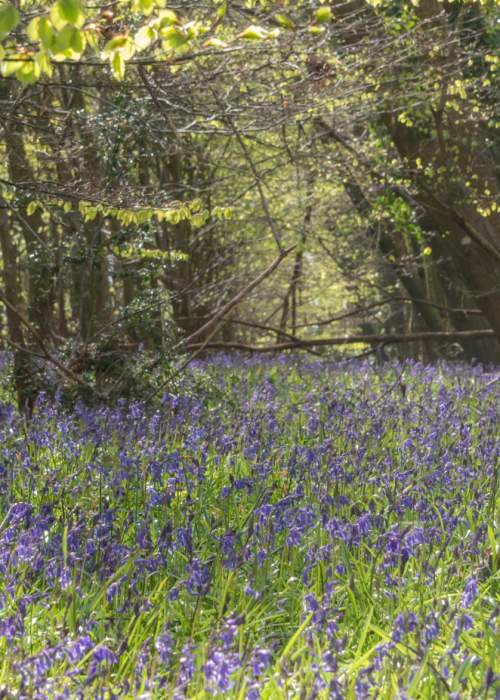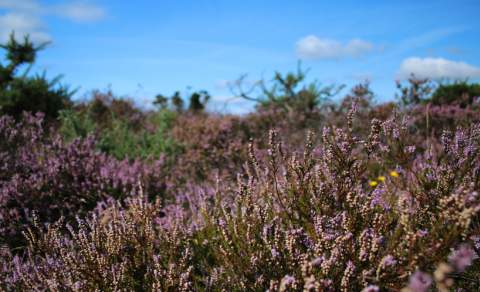New Forest Bluebells
The beautiful wash of colour as a carpet of bluebells covers the woodland floor is a long-awaited sight which paints the picture of spring in the New Forest.
Our ancient woodlands not only come to life with the fresh greens of spring but also the blue and purple tones and distinctive scent of our beautiful bluebells. It’s not a surprise that the bluebell is one of the UK’s most popular wildflowers!
Bluebells of the New Forest
The British (or English) bluebell has a range that extends across the UK into northern Europe and the northwest of Spain. Most of the year the bluebell spends its live as a bulb underground before the glossy green leaves begin appearing in March. Bluebells usually flower throughout mid-April to late May. By flowering early, bluebells can maximise on the sunlight before all of the trees in the canopy above have developed leaves. Once the flowers have emerged, they will eventually stand about 30cm tall with bell-shaped buds. It is easy to tell the native bluebell apart from the non-native species by taking a look at the colour of the pollen. Native bluebells have a creamy white pollen, whereas non-native can have different coloured pollen, including blue.
Bluebells tend to occur in large clusters, creating a stunning display of colour in broadleaved woodlands, hedgerows and in fields.
They are an important source of nectar for many species of invertebrate including bees, hoverflies and butterflies. Native bluebells are under threat from not only overdevelopment but the non-native species. In the New Forest, it is illegal to plant non-native species under a local by-law. The English bluebell is also protected by the Wildlife and Countryside Act (1981) which means they are not allowed to be dug-up and sold.
The New Forest has 34 square kilometres of broad-leaved enclosures, where bluebells flourish under the canopy of trees.
Where are the best places to spot bluebells in The New Forest?
There are several places to spot these beautiful flowers within The New Forest during the spring months, these tend to be areas with less grazing. Here, we give our top five places to see bluebells:
Pondhead Inclosure
Pondhead Inclosure is a well-fenced area to the southeast of Lyndhurst. The inclosure is protected from roaming stock and wild deer, which helps to increase the biodiversity of the land. The inclosure is listed by the Forestry Commission as one of their top 10 woodlands to view bluebells in the country. Volunteers as part of the Pondhead Conservation Trust, along with the Forestry Commission help keep the area maintained. Look out for open days taking place during spring or take a short walk through the inclosure and take in the amazing carpet of colour. Just don’t forget your camera!
Broomy Inclosure
Broomy Inclosure can be found north of Linwood and to the southeast of Fordingbridge. There are several paths which criss-cross the inclosure. An extensive carpet of bluebells which have been left less protected by the relocation of a boundary fence which had kept stock and deer away.
Exbury Gardens
Exbury Gardens and the Summer Lane approach offers a two-mile drive with bluebell drifts. The gardens open in March for its new season and bluebells can often be seen along with azalea, camellia and rhododendron.
Roydon Woods
Roydon Woods, is just over a mile to the southeast of Brockenhurst and is a 1,000 acre nature reserve owned by the Hampshire and Isle of Wight Wildlife Trust. The reserve has plenty of good vantage points. The area is un-grazed ancient woodland which helps to keep the bluebells flourish.
The main entrance to Roydon Woods is at Setley, map ref SU 306004. To get to Roydon Woods take the A337 south from Brockenhurst to Setley. Parking is very limited but roadside parking can be found nearby. The reserve is located at the end of a gravel track.
Pedestrian access is from the Filly Inn beside the A337 at Setley. walk east along the bridleway to the main entrance. Public bridleways and a series of waymarked permissive footpaths provide access to much of the area while keeping wildlife disturbance to a minimum and maintaining the tranquillity visitors enjoy.
There is a temporary dog exclusion zone on part of the heathland to protect ground nesting birds each spring.
Sandleheath
Sandleheath can be found to the west of Fordingbridge. There are a network of public footpaths and bridleways in the area leading you through the ancient woodlands. You’ll often find the bluebells here bordered by primroses and other spring flowers.
Bank
The cycle route between New Park, Brockenhurst and Bank, near Lyndhurst is especially good for bluebell spotting.
Furzey Gardens
Furzey Gardens can be found in Minstead, near Lyndhurst. The gardens are a social enterprise which helps people with learning difficulties. The 10 acres of woodland garden come to life in the spring with bluebells, azaleas and rhododendron.
As you can see, there are some fantastic places to spot bluebells in the New Forest. Why not book a spring break and come and see them for yourself?
Have you seen any bluebells on your visit to the New Forest? If so, then don’t forget to share your photos with us on social media at @TheNewForestUK on Facebook, Instagram and Twitter.





